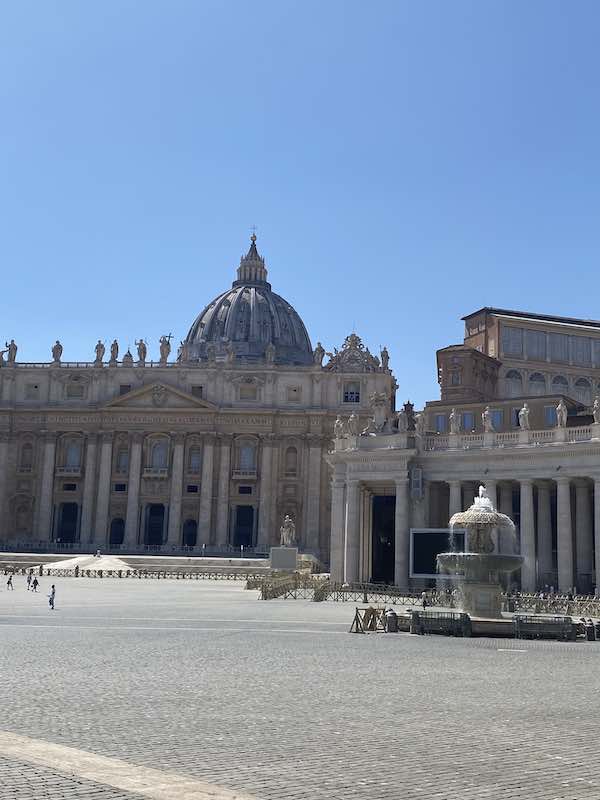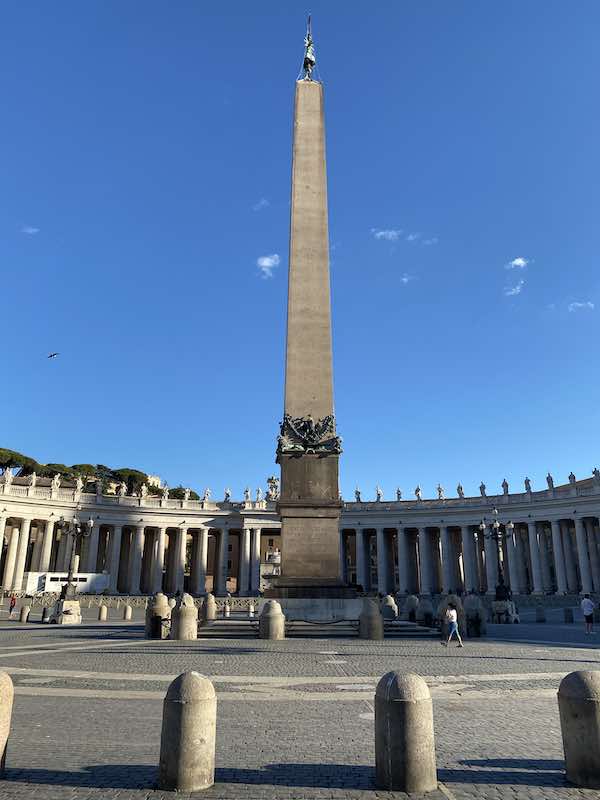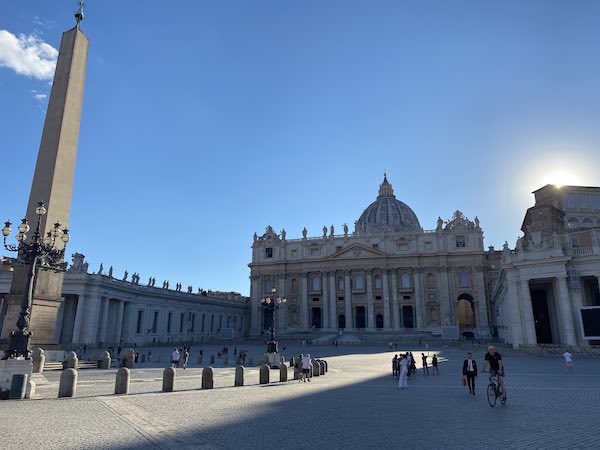All you need to know about St Peter Square, Vatican City: interesting facts, brief history, what to see, what makes it special.
St Peter Square or Piazza San Pietro, as it is called in Italian, is the large monumental square with St Peter’s Basilica, in the Vatican City, within the city of Rome.
Designed by architect Bernini, it is one of the most beautiful squares in Rome and one of the grandest and most elegant in the world.
This is all you need to know about St Peter square and practical tips to plan your visit.
Please note: this post contains affiliate links and, should you make a purchase through them, we might make a small commission.
Where is St Peter Square and how to get there
St Peter’s Square is located in the Vatican City, inside the city of Rome, Italy.
The square is close to the river Tiber and lies at the base of the ancient Mons Vaticanus, the Vatican Hill, still visible at the back of the basilica (now the Vatican Gardens).
The main street leading into the square from the city center and the river is called Via della Conciliazione, which act as a monumental entry to the Vatican area and dates from Fascist times, and the square is also accessible from the lovely streets of Borgo, the neighborhood immediately to its left and its original access point.
The buses stopping closets to St Peter square are 23, 34, 40, 46, 62, 64, 98, 881, 916, 982, tram 19 and Metro A Ottaviano/San Pietro station.
The square itself is closed to traffic and no buses nor cars nor tour buses are allowed. All these buses stops however are walking distance from the square.
Tips for visiting St Peter Square
St Peter square is a large outdoor space and access is free.
You do not need tickets to enter the square and you can wander here like into any other city piazza.
A wooden fence protects part of the piazza but it has opening to allow you to walk in easily.
The colonnade of St Peter Square marks the border between the Italian state and Vatican city however, no border control is in place and no passport is needed to enter the square.
Unlike for St Peter Basilica, there is no dress code to visit St Peter square.
In practical terms, it is advisable to wear comfortable shoes and, if you intend on visiting the church or the museums, modest clothing that doesn’t reveal legs or shoulders (you can find our tips about Rome dress code here).
If you intend of visiting the church, be advised that security checks are carried out at several points of entrance. Bags will be checked and temperature checks are also carried out.
Please note that access to the Vatican museums and the Sistine Chapel is not on the square. Make sure you plan your day here leaving sufficient time to get form one to the other.
You do not need tickets to visit St Peter Square and access to the main floor of St Peter’s Basilica is free and non ticketed as well.
However, you can book:
- St Peter Basilica Guided Tour (reserved entrance)
- St Peter Basilica Tour and St Peter Dome Climb
- St Peter Basilica, St Peter Dome and Papal Tombs tour
Brief history of St Peter Square
St Peter Square as we see it now dates from the XVII century and is the result of the work and genius or architect Gian Lorenzo Bernini.

At the time, Pope Alexander XII commissioned work to create a square that allowed ‘the largest possible number of people’ to attend the blessing by the Pope and assigned the task to Gian Lorenzo Bernini, already a very popular architect in Rome with many designs under his belt.
Bernini designed St Peter Square following an ambitious idea aimed at showcasing at best Saint Peter Basilica, the focal point of his vision.
To highlight the symbolic importance of the church, he built a square that would draw the eye of the visitor to the basilica, all the lines in the square somehow leading the attention and the vision to the same spot.
He achieved this creating several areas with different geometrical shapes, converging at the church, and managed to create a square that both highlighted the church and acted as a landmark of great beauty itself.
The main elements making up St Peter square are:
- A trapezoidal area, immediately outside of the church, elevated from the rest of the square
- Two curved colonnades facing each other and framing the central area of the piazza
- 2 fountains, that added lights and sound to the space, to make it a more comprehensive experience
- Over 140 statues
- An obelisk
- The facade of St Peter basilica that, while already in existence at the time of the construction of the square, operates as its focal point and most important element.
These and more recent additions are the best things to see in St Peter Square. Here are some details about each.
What to see in St Peter Square
The square itself
Gian Lorenzo Bernini designed St Peter Square as an area of great visual impact and the best way to approach this piazza is indeed to take in its majesty, before diving into the smaller details that make this such a wonderful Rome landmark.
The square is very big. St Peter Square is 240 meters wide and over 300 long and it is said to be able to take up to 300.000 people.
As you arrive into it, the square feels like it wraps around you at 360 degrees: despite the space, the colonnade give a sense of containment and indeed leads your attention to the basilica, towards which both your eye and your steps are drawn.
St Peter Square colonnade
The colonnades of St Peter square are one of the great masterpieces by Bernini.
They are designed to form two semicircular structures (emicycles) framing the square, made with 44,000 cube meters of travertine marble, coming from nearby Tivoli.

The colonnade, at their widest point, give the square a diameter of 240mt and it is made with 284 columns in doric style, each 16mt high, arranged in 4 rows.
The positioning of each column was carefully studied by Bernini who managed to create a very special visual effect we can still admire today.
The colonnade is made of 4 rows of columns and these are easily visible from almost anywhere in the square as well as when walking along the three walkable lanes among the columns themselves.
However thre are is a precise spot in St Peter square, the exact center of the colonnade (marked on the ground) from where the columns disappear!
If you stand right on that spot, the several rows of the colonnade all align giving the impression of one single row.
This visual effect is called force perspective and even if you expect it, it is so peculiar it has you catch you breath it is so peculiar!
When describing his idea for the colonnade, Bernini said he wanted the two semicircular structrures to act as arms or wings, symbolizing the church opening its arms to the faithful.
This symbolism is not lost in the current set up of the square but the visual impact got altered when large Via della Conciliazione was built.
To fully appreciate Bernini’s vision, we need to imagine the area as it was at his time, access being from the small streets of Borgo rather than from a monumental road.
The colonnade has 140 statues on top, 70 per side.
They represent mostly saints while those on the façade of the basilica represent Jesus and the apostles.
St Peter’s Square obelisk
The obelisk in the center of St Peter square predates the square itself and was already here when Bernini decided to incorporate it in his design.
It is one of the 13 ancient obelisks in Rome and originally came to Rome from Egypt in 40AD, by order of Emperor Caligula, who placed in its circus.

The obelisk moves to its current location in 1586, by order of Pope Sixtus V who wanted to add to it religious inscription and a cross on top, to symbolize the thriumph of Christianity over paganism and the connection between the earth and the sky.
Fun fact: the obelisk used to have a globe on top that was said to have preserved the ashes of Julius Caesar.However, when the globe was open and then replaced with the cross we see now, it was discovered to be empty. Some say the opening of the globe released his ghost, still roaming the area! You can learn about this and other Rome ghost stories here.
The fountains
Piazza San Pietro has two fountains, located in the exact position of the two focus points of the ellipsis formed by the colonnades.

The two fountains are milar to each other but not identical.
The one to the right, if facing the basilica, was made by Modern, who created it 1614 using materials and parts from a previous in the same location.
His genius lead him to create a shape for the top of the fountain that made the cascading water fall into a myriad of small droplets rather than a solid cascade this gave and still gives the fountain the ability to refract the light with exceptional brightness and intensity.
The fountain to the left is by Bernini himself in 1677: he stayed close to the model of the previous fountain but added dolphins at its base that make the fountain unique.
The statues
St Peter square is overlooked by many statues, perched on top of the colonnade as well sa the top of the façade of the basilica.
The statues above the colonnade represents saints and popes while those at the top of the façade, in front of the dome, represent Jesus, the apostles, and St John the Baptist.
St Peter basilica
St Peter basilica dominates St Peter Square.
It is the building the eye goes to when entering the square, tanks to Via della Conciliazione, the main one you see as soon as you cross the river from Rome city center.

The basilica has a long history that has its roots in the very beginning of the history of Christianity.
The basilica as we see it now is the result of work carried out mostly during the Renaissance and the Baroque period however, it lied on tops of a much older church that Emperor Constantine wanted in the IV century AD to mark the spot where the apostle Peter was buried.
This first church was a place of pilgrimage during the middle ages and in 1500s Pope Julius II gave order to build a new one, which he commissioned to Donato Bramante.
The original plan for this new church was a Greek Cross shape however, after the death of Bramante many architects and artists worked on the project including Raffaello Sazio and Michelangelo who is largely responsible for the structure of the church as we see it now as its dome.
Michelangelo died before completing the project and architect Moderno and Dalla Porta completed it, creating among other things the façade of the basilica and, in the case of Moderno, the upgrading of the fountain in front.
St Peter’s Basilica is one of the most beautiful in the world and it has several world of art and treasures worth seeing including, among the many others, the incredible Pieta’ by Michelangelo and the main altar baldachin by Bernini.
You can read all our tips for visiting St Peter basilica here.
The Pope’s window
St Peter square want created to welcome the faithful and allow the largest possible number of people to participate in the Papal blessing and this is role the square still holds every Sunday, when the Pope appears at the window of the Vatican Palace (Top right side of the square) to say the Angelus.
Angels Unawares statue
Since 2019 St Peter Square is home to a beautiful, modern piece of art called Angels Unawares.
This monument represents people of different origin, age, background and time all united by the dramatic experience of migration, with a pain go angel wings at the top of the ensemble.

The monument is a tribute to the tragedy of migration and Pope Francis wanted it on the square as a reminder of the evangelical call to hospitality and the original Christian message.
The statue is free to see and it is on the left of the square, when looking towards the basilica.
I hope you enjoyed this quick overview of St Peter’s Square, its history and our tips for visiting. Safe travel planning!

